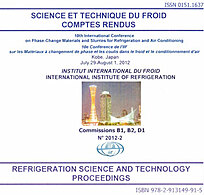
IIR document
Numerical simulation of supercooled water flow with an ice crystal in a two-dimensional duct.
Number: pap. P04
Author(s) : TSURUGASAKI T., TATSUTA K., HAGIWARA Y., et al.
Summary
The authors carried out a numerical simulation of laminar supercooled water flow in a two-dimensional duct. An ice crystal grew from a location of one wall of the duct. An immersed-boundary method and the Phase Field equation were utilized to determine the interface. The Navier-Stokes equation was solved with finite difference methods. It was found from the computational results that, as the Reynolds number became higher, the growing dendrite arm to upstream became thicker. Moreover, since the released latent heat in the upstream direction was transported downstream by flow, the temperature gradient near the interface developing upstream became steep and the conduction in-side the arm became noticeable. These findings indicate that there is a strong correlation between temperature gradient around the interface and ice growth velocity. Also, they carried out numerical simulation of similar water flow with an ice particle carried by the flow. The computational results showed that the relative velocity near the interface was reasonable. In addition, a high temperature region was seen in the area upstream from the ice particle.
Available documents
Format PDF
Pages: 8 p.
Available
Public price
20 €
Member price*
Free
* Best rate depending on membership category (see the detailed benefits of individual and corporate memberships).
Details
- Original title: Numerical simulation of supercooled water flow with an ice crystal in a two-dimensional duct.
- Record ID : 30005102
- Languages: English
- Source: 10th International Conference on Phase-Change Materials and Slurries for Refrigeration and Air Conditioning. Proceedings: Kobe, Japan, July 29-August 1, 2012.
- Publication date: 2012/07/01
Links
See other articles from the proceedings (46)
See the conference proceedings
Indexing
-
Improvements for the ice slurry production with...
- Author(s) : GUND S., SCHMID O., KAUFFELD M.
- Date : 2022/06/13
- Languages : English
- Source: 15th IIR-Gustav Lorentzen Conference on Natural Refrigerants (GL2022). Proceedings. Trondheim, Norway, June 13-15th 2022.
- Formats : PDF
View record
-
Flow behavior and phase equilibrium of TBPB hyd...
- Author(s) : CLAIN P., NDOYE F. T., DELAHAYE A., et al.
- Date : 2012/07/01
- Languages : English
- Source: 10th International Conference on Phase-Change Materials and Slurries for Refrigeration and Air Conditioning. Proceedings: Kobe, Japan, July 29-August 1, 2012.
- Formats : PDF
View record
-
Comparison of selected PCMs for building applic...
- Author(s) : OSTRÝ M., CHARVÁT P., PRIKRYL R.
- Date : 2012/07/01
- Languages : English
- Source: 10th International Conference on Phase-Change Materials and Slurries for Refrigeration and Air Conditioning. Proceedings: Kobe, Japan, July 29-August 1, 2012.
- Formats : PDF
View record
-
Measurement of thermal conductivity of TBAB CHS...
- Author(s) : ZHANG P., MA Z. W.
- Date : 2012/07/01
- Languages : English
- Source: 10th International Conference on Phase-Change Materials and Slurries for Refrigeration and Air Conditioning. Proceedings: Kobe, Japan, July 29-August 1, 2012.
- Formats : PDF
View record
-
Study on supercooling degree of water-based gra...
- Author(s) : WANG J., LIU Y., JIN X., et al.
- Date : 2019/08/24
- Languages : English
- Source: Proceedings of the 25th IIR International Congress of Refrigeration: Montréal , Canada, August 24-30, 2019.
- Formats : PDF
View record
